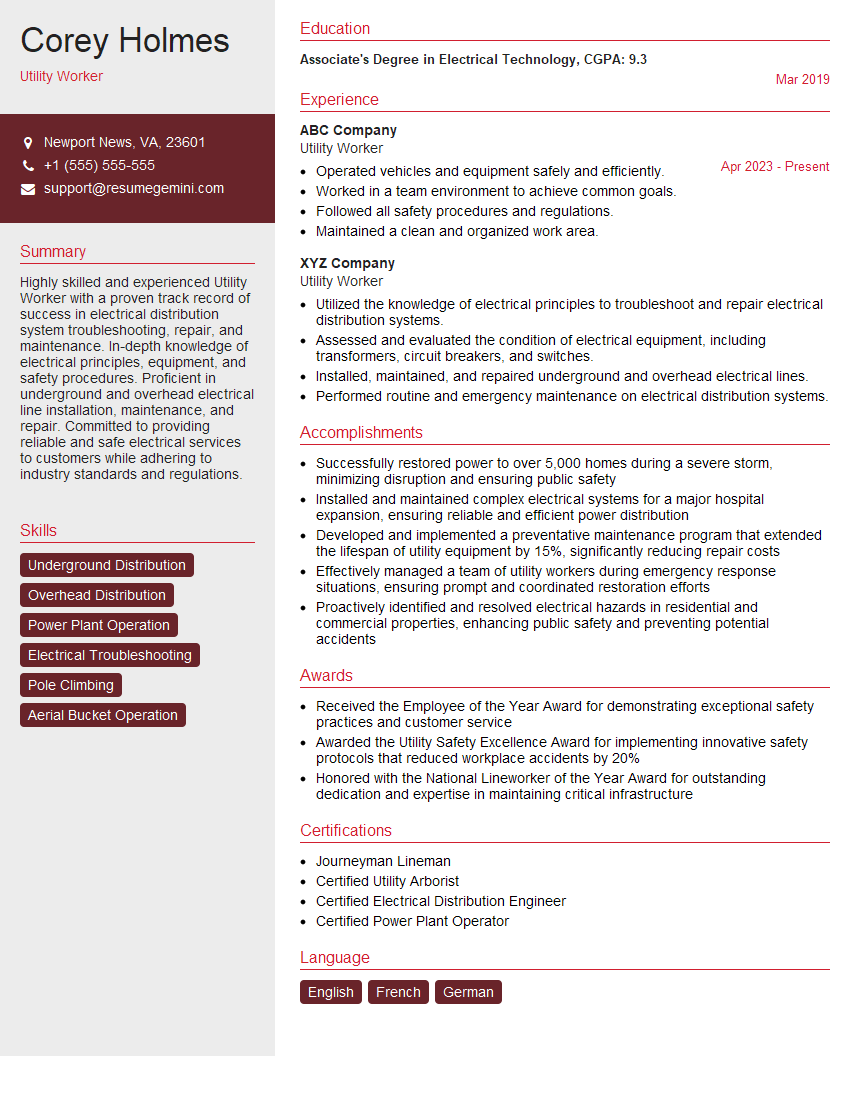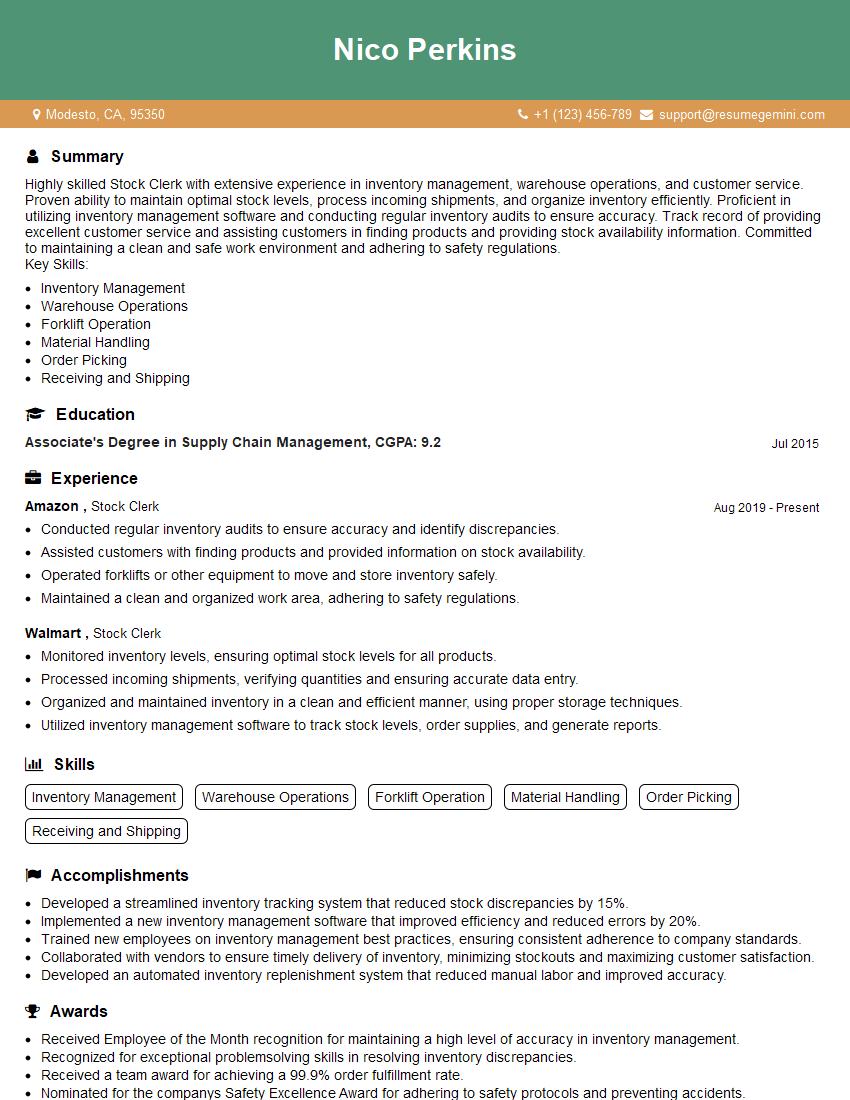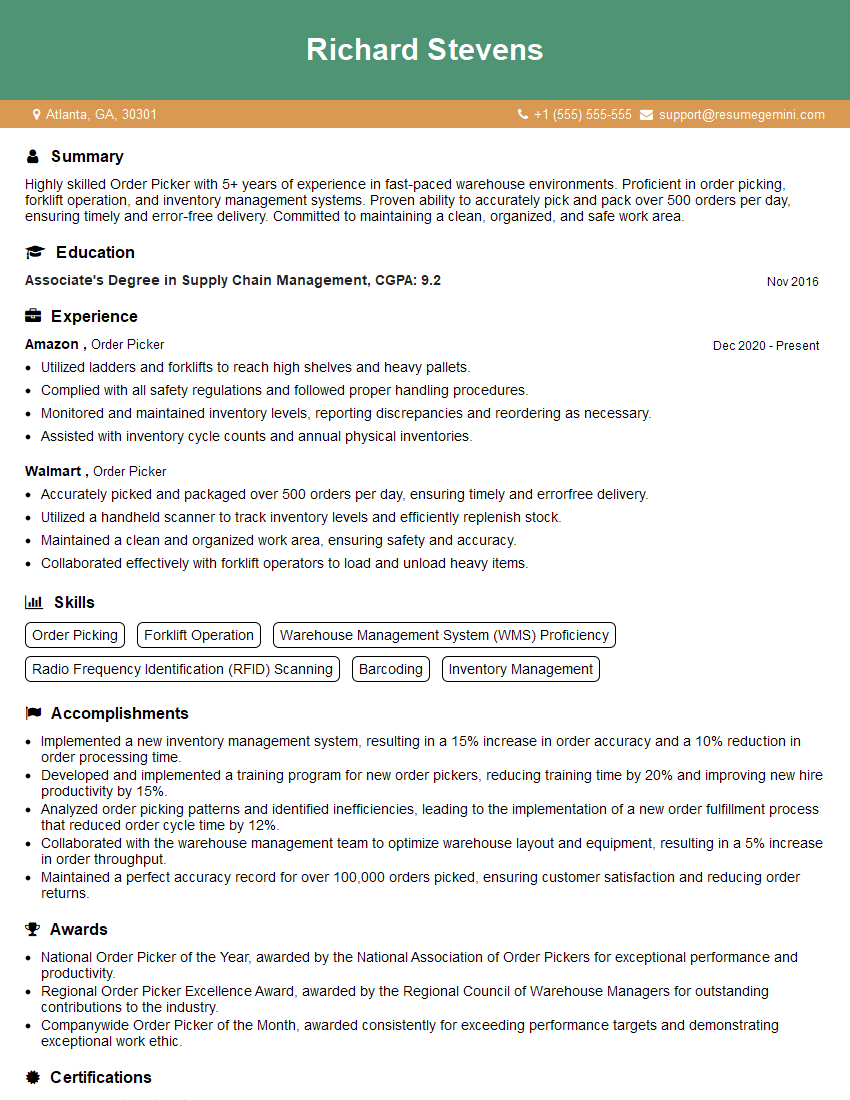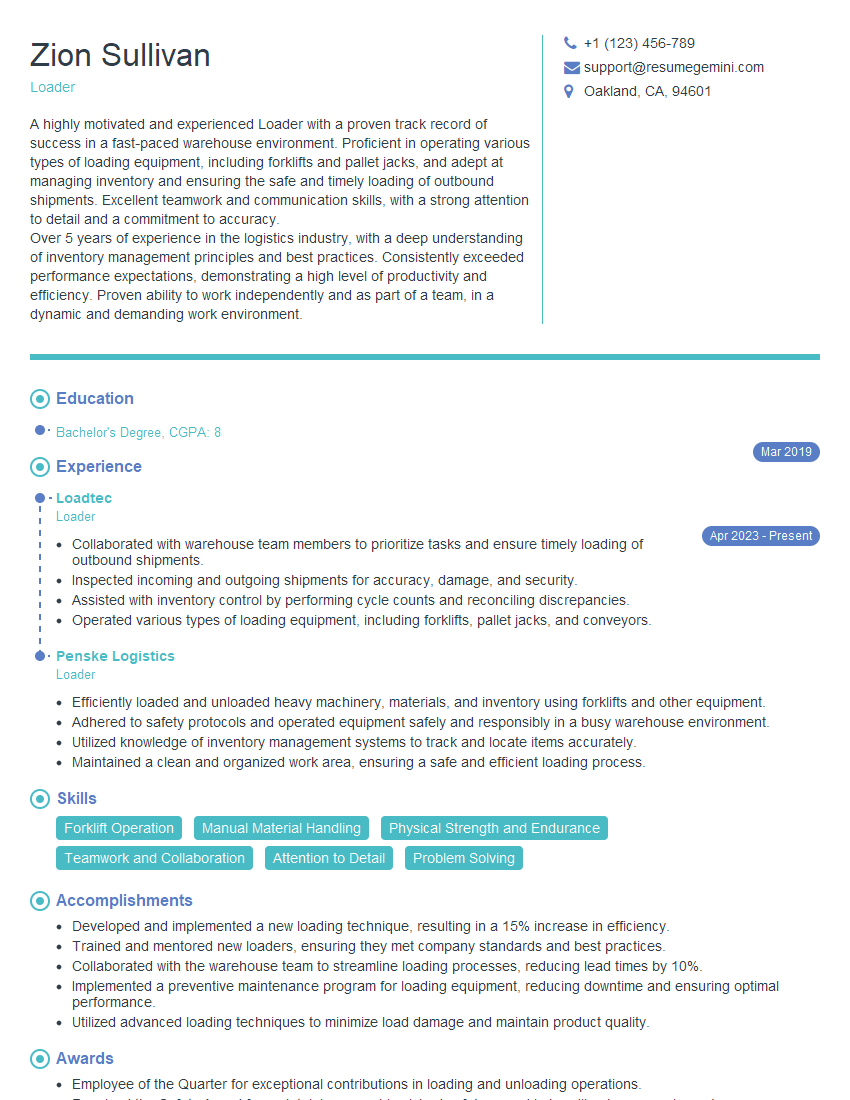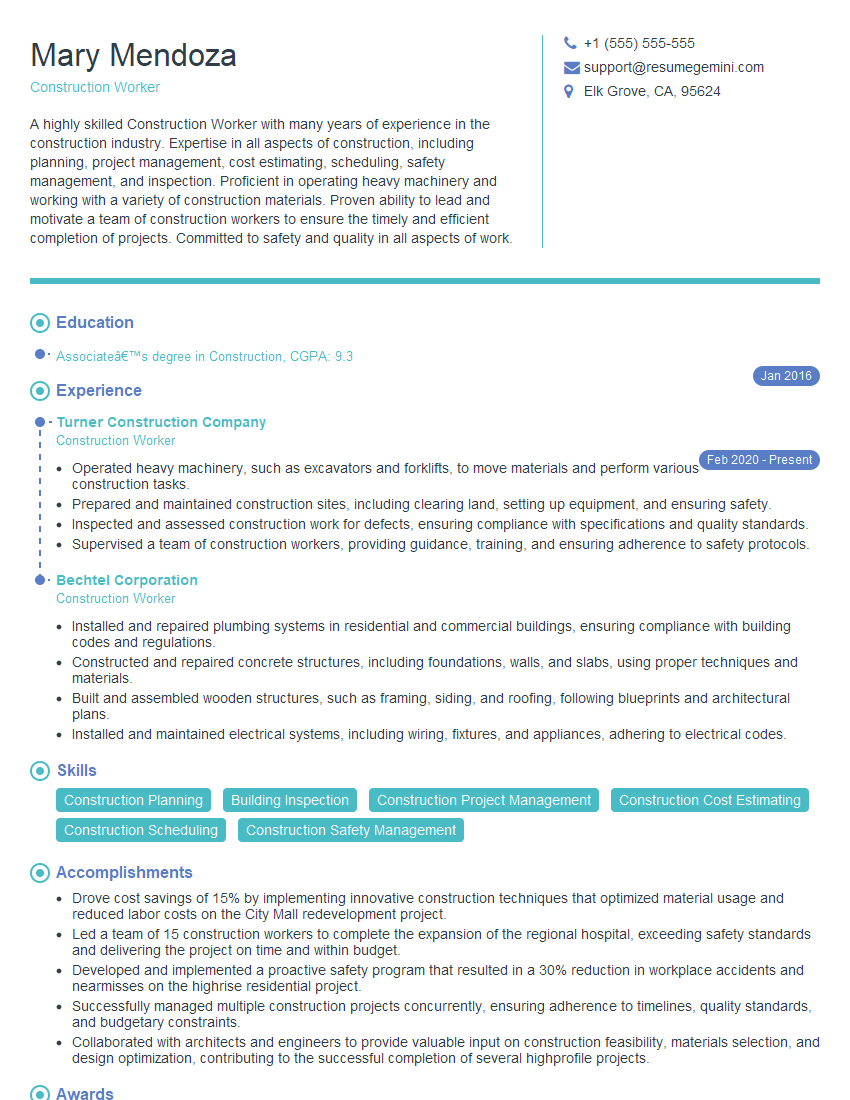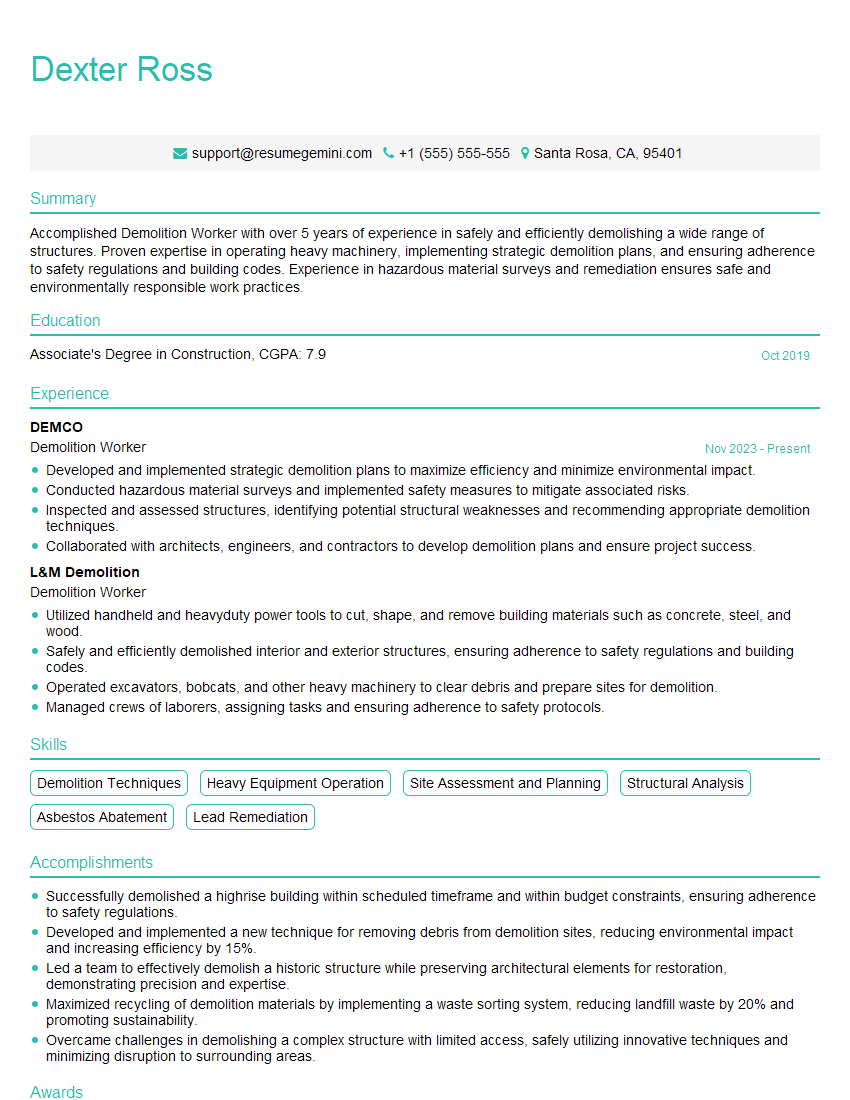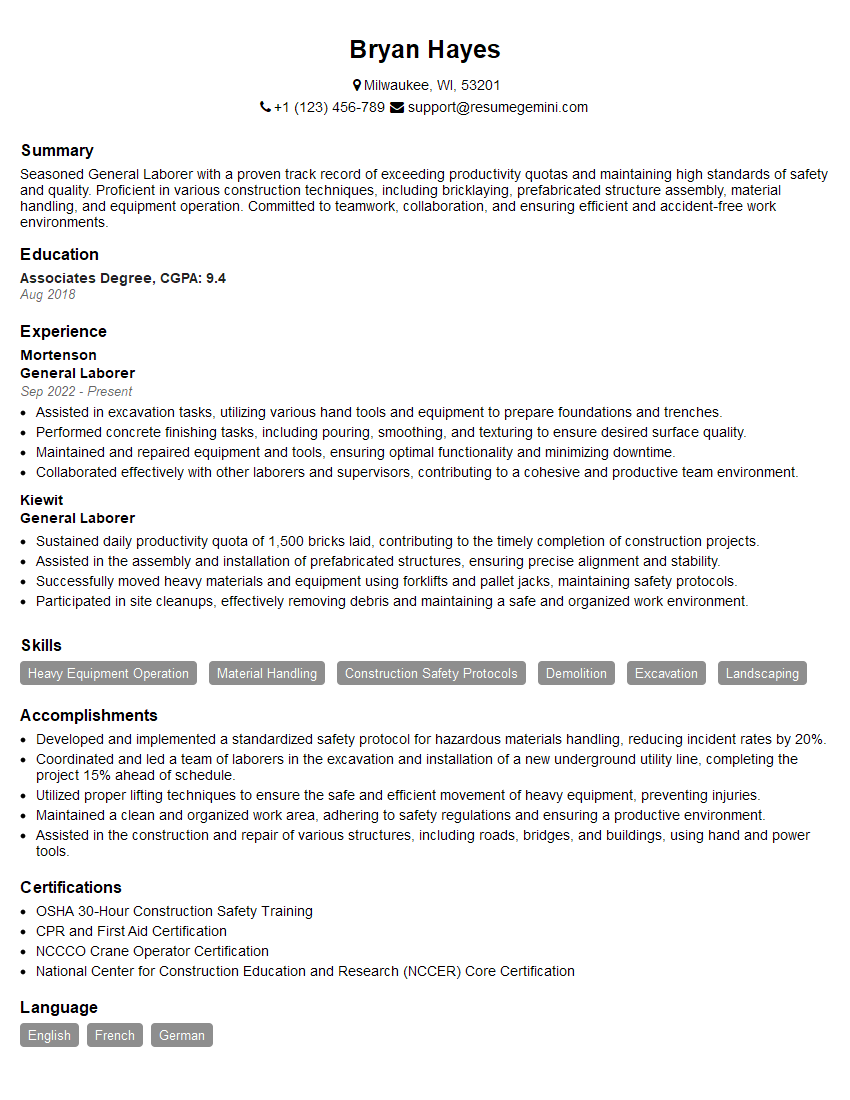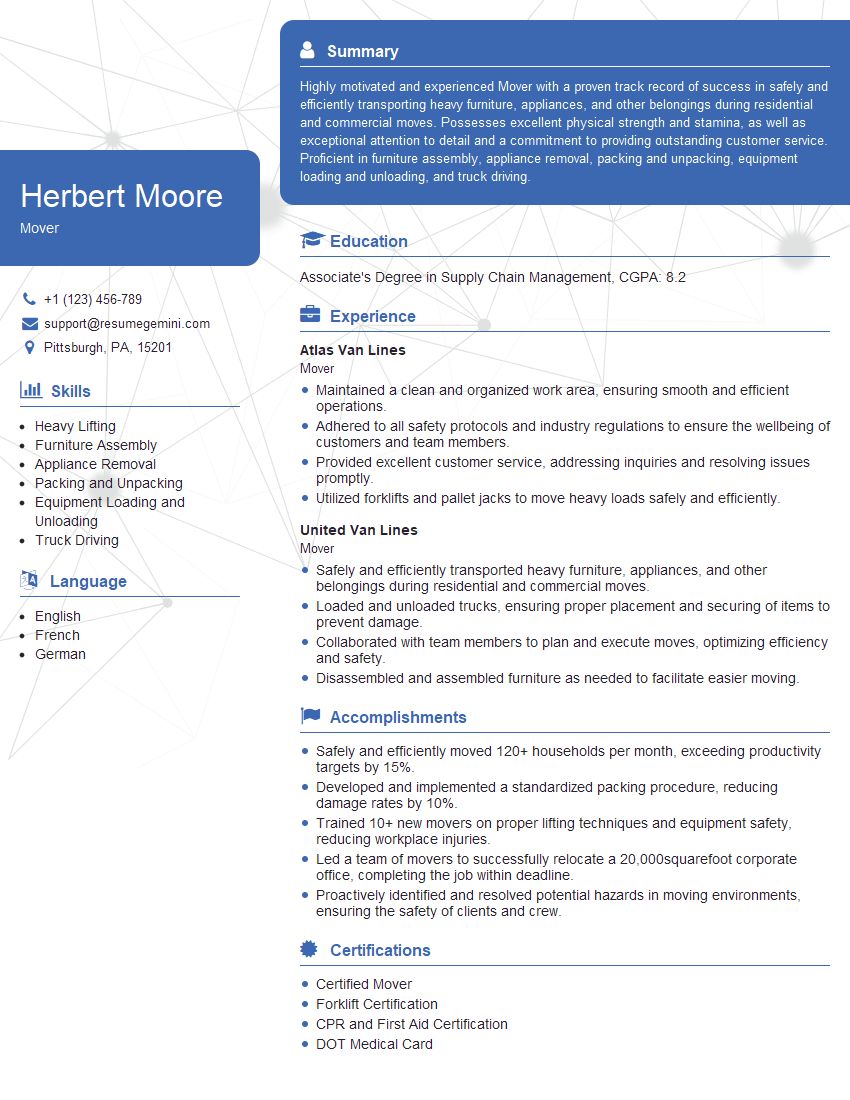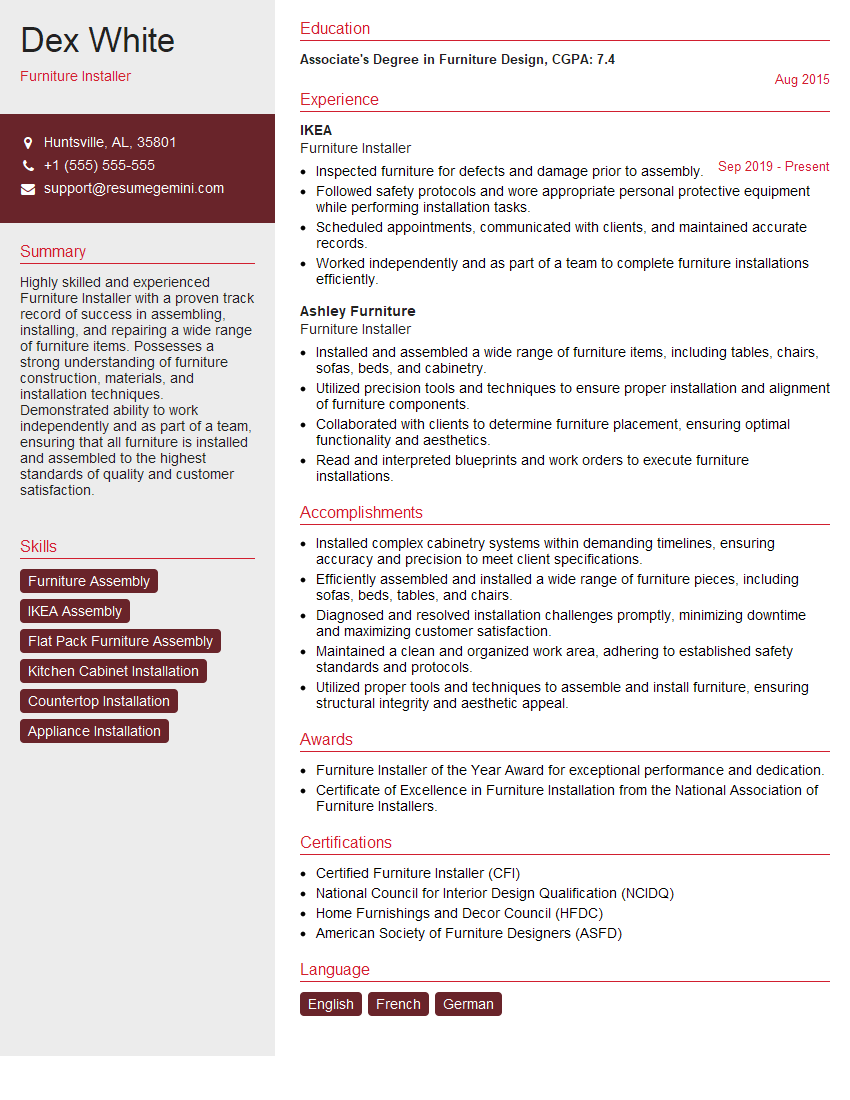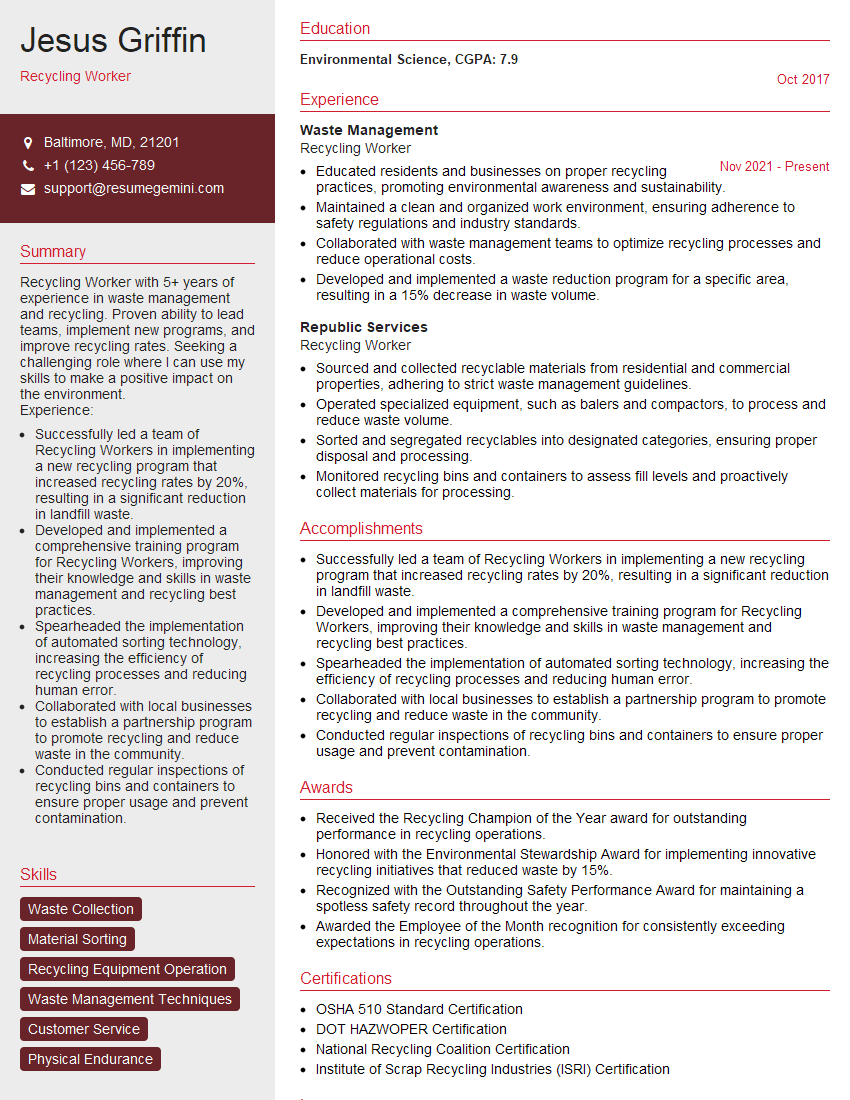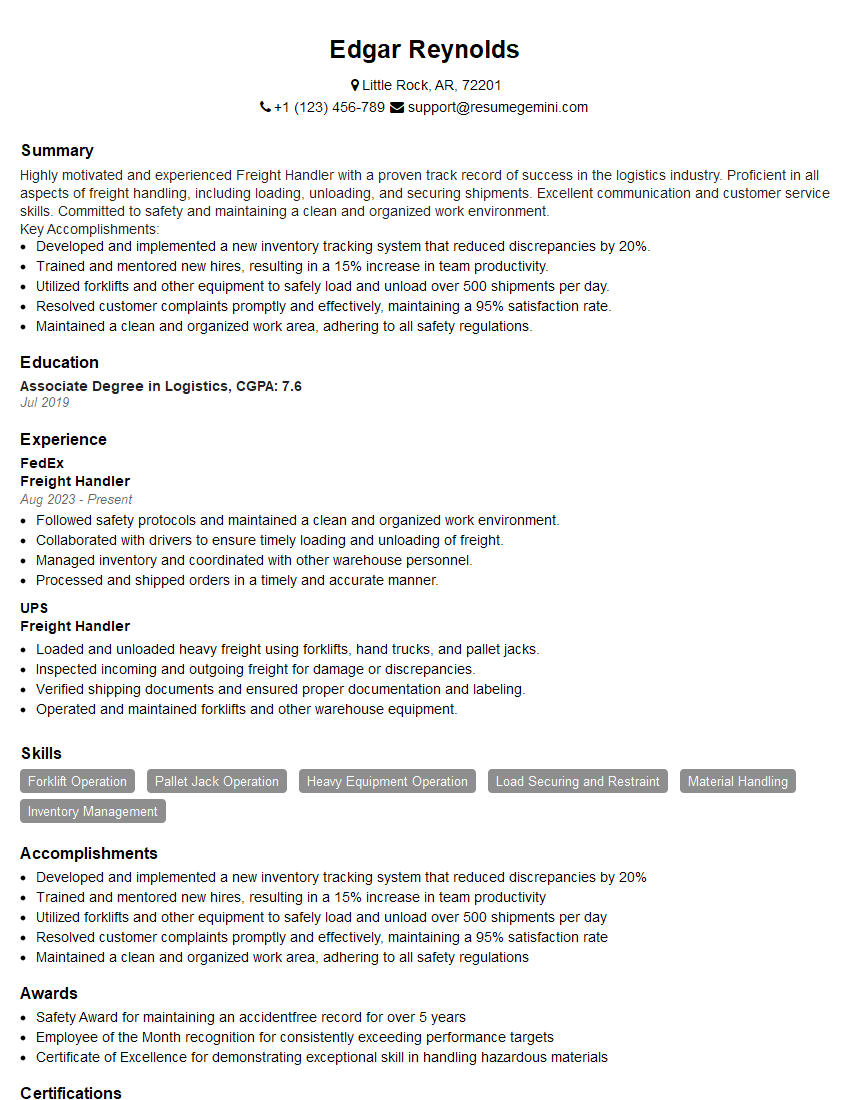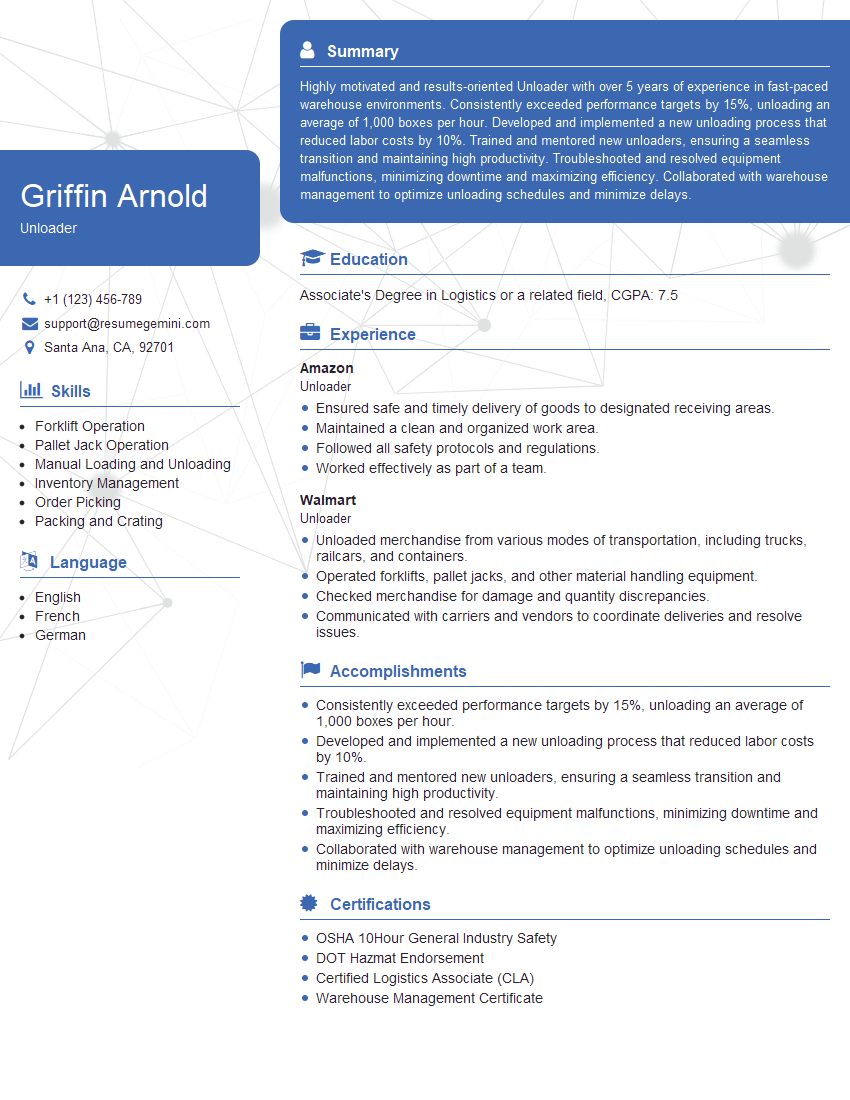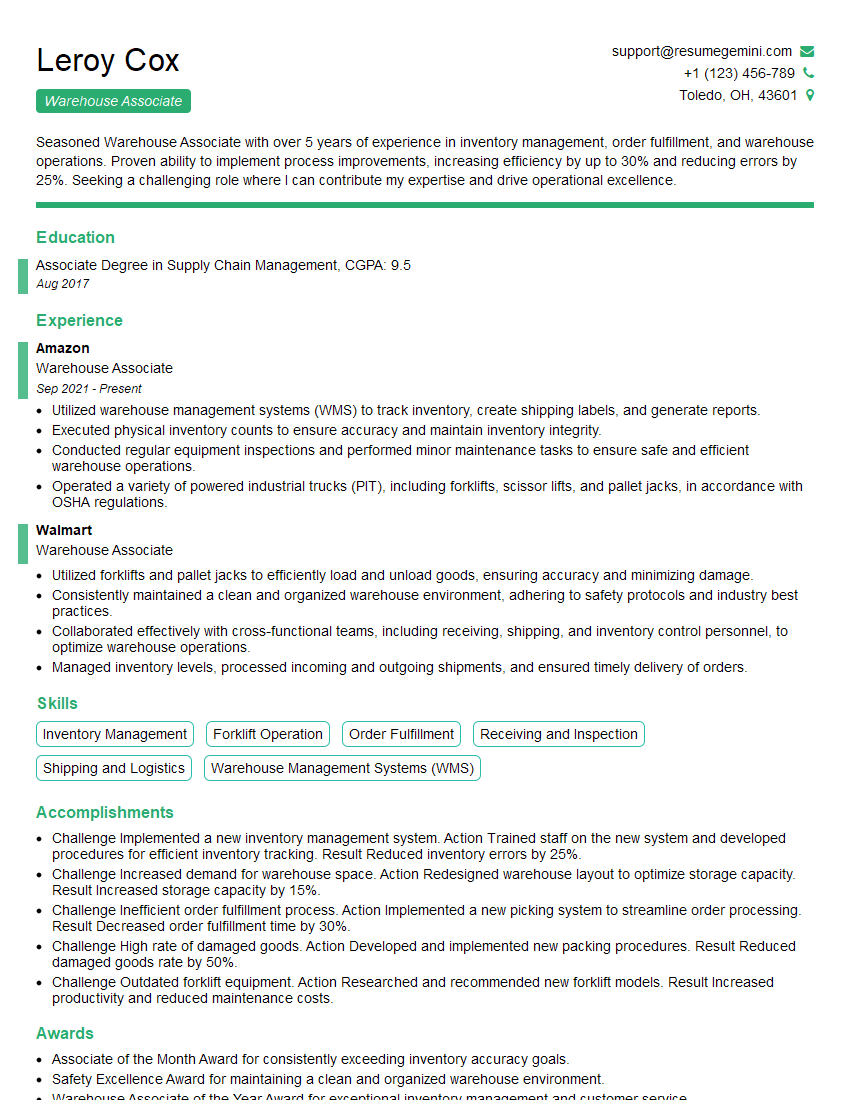Every successful interview starts with knowing what to expect. In this blog, we’ll take you through the top Physical fitness and endurance to perform manual lifting tasks interview questions, breaking them down with expert tips to help you deliver impactful answers. Step into your next interview fully prepared and ready to succeed.
Questions Asked in Physical fitness and endurance to perform manual lifting tasks Interview
Q 1. Describe your experience with manual lifting tasks.
My experience with manual lifting tasks spans over 15 years, encompassing a variety of settings, from warehouse environments to construction sites and even assisting with furniture installations. I’ve handled diverse objects, ranging from small packages to heavy machinery components, consistently prioritizing safety and efficiency. This extensive experience has honed my skills in assessing weight, employing proper lifting techniques, and recognizing potential hazards. I’ve successfully managed hundreds, if not thousands, of lifting operations without incident, showcasing a strong commitment to safe practices and a deep understanding of physical limitations.
Q 2. What is your maximum safe lifting capacity?
My maximum safe lifting capacity, according to my most recent strength assessment, is 50kg (approximately 110 lbs). However, this is a guideline and is influenced by several factors including the object’s size, shape, distance it needs to be moved, and the overall environment. For heavier objects, I always seek assistance or utilize mechanical aids like forklifts or pallet jacks to avoid injury and ensure the safety of myself and others. It’s crucial to remember that ‘maximum safe lifting capacity’ is not a static number; it’s dynamic and varies based on individual physical condition and external circumstances.
Q 3. How do you prioritize safety when performing manual lifting?
Safety is my paramount concern in any lifting task. My approach follows a systematic process:
- Assessment: I meticulously assess the weight, size, shape, and stability of the object and the surrounding environment before attempting a lift. This includes identifying potential obstacles and hazards.
- Planning: I plan the lift, considering the most efficient and safe path. I check for sufficient space and proper footing.
- Assistance: If the object is too heavy or awkward, I immediately seek assistance from colleagues or use appropriate mechanical lifting equipment.
- Technique: I always utilize proper lifting techniques, maintaining a straight back and bending my knees (more on this in the next answer).
- Communication: Clear communication is key, especially in team lifts. I make sure everyone understands the plan and their roles.
Q 4. Explain your understanding of proper lifting techniques.
Proper lifting techniques are fundamental to injury prevention. Think of it like this: your body is a machine, and efficient operation requires correct form. The key elements include:
- Assess the load: Get a good look at the object. Is it too heavy? Can I safely lift it alone?
- Get close: Position yourself as close to the object as possible to reduce strain on your back.
- Bend your knees, not your back: Keep your back straight. Bend at the hips and knees, lowering your center of gravity.
- Keep the load close: Hold the object close to your body, distributing the weight evenly.
- Lift with your legs: Use your leg muscles to power the lift, not your back.
- Maintain a stable base: Keep your feet shoulder-width apart for balance.
- Look ahead: Keep your head up and your eyes on your path.
- Lower safely: Reverse the process to lower the object, bending your knees and controlling the descent.
Imagine lifting a heavy box. Incorrectly lifting it could strain your back, causing injury. Using proper technique minimizes this risk by properly distributing the weight and using stronger leg muscles.
Q 5. How do you assess the weight of an object before lifting?
Assessing the weight of an object before lifting is crucial. I use a combination of methods:
- Visual Inspection: I carefully examine the object’s size and material. A large, dense object will obviously weigh more than a small, lightweight one.
- Physical Estimation: I may try to gently nudge or push the object to get a sense of its weight. This gives a better understanding of its mass.
- Knowledge of similar objects: If I have experience lifting similar objects previously, I can estimate the weight more accurately.
- When in doubt, ask for help or use equipment: If I’m unsure, I won’t risk it. I’ll seek assistance or utilize the proper lifting equipment.
For example, if I’m presented with an unusually large cardboard box, I’d try to assess the material to see how full it is, and if needed, I’d ask if there was a way to move it using a pallet jack.
Q 6. What steps do you take to prevent injuries during manual lifting?
Preventing injuries during manual lifting involves a multi-faceted approach encompassing:
- Regular physical fitness: Maintaining strength and flexibility in my core, legs, and back is crucial. Regular exercise, including strength training and stretching, is vital.
- Proper posture and ergonomics: Consistent adherence to the proper lifting techniques described previously is paramount.
- Use of lifting aids: Understanding the appropriate use of lifting aids such as hand trucks, dollies, and lifting straps is essential. Never hesitate to use available equipment.
- Seeking assistance: Never hesitate to ask for assistance if a load is too heavy or awkward. Teamwork prevents injuries.
- Reporting hazards: Immediately report any unsafe conditions or equipment malfunctions that could lead to lifting injuries.
- Understanding personal limitations: Recognizing my own physical limitations and avoiding situations that exceed my capabilities is non-negotiable.
Q 7. Describe a situation where you had to lift a heavy object. What was your approach?
Once, I had to move a large, heavy piece of industrial equipment – approximately 75kg (165 lbs). It was awkwardly shaped and difficult to grasp securely. Instead of attempting it alone, I immediately gathered two colleagues. We then carefully assessed the weight and shape, planned a lifting strategy, and ensured a clear path. We used the correct posture – bending our knees and keeping our backs straight – and coordinated our lift, counting down before we all lifted simultaneously. Clear communication was crucial to ensure a safe and successful lift. By working as a team and utilizing proper lifting techniques, we moved the equipment without incident. This highlights the importance of teamwork and a collaborative approach to heavy lifting.
Q 8. How do you maintain your physical fitness to perform manual lifting tasks?
Maintaining peak physical fitness for manual lifting involves a holistic approach encompassing strength training, cardiovascular health, and flexibility. Think of it like building a strong, well-oiled machine.
Strength Training: I focus on compound exercises like squats, deadlifts, lunges, and overhead presses to build strength in my legs, core, and back – the muscles crucial for safe lifting. I vary the exercises and weights to prevent plateaus and injuries. For example, I might incorporate kettlebell swings for explosive power and Romanian deadlifts for hamstring and back strength.
Cardiovascular Health: Regular cardio, such as running, swimming, or cycling, improves endurance, crucial for handling multiple lifting tasks throughout a workday. It enhances blood flow, delivering oxygen and nutrients to muscles, aiding in recovery and preventing fatigue.
Flexibility and Mobility: Maintaining flexibility through stretching and yoga prevents muscle tightness, which can lead to poor posture and increased injury risk. Regular stretching improves range of motion, making it easier to maneuver during lifts and reduces the strain on joints.
Proper Nutrition and Hydration: A balanced diet rich in protein supports muscle growth and repair, while adequate hydration is essential for optimal muscle function and recovery. This fuels my body for demanding physical work.
Q 9. How would you handle a situation where you are unable to lift an object safely?
Safety is paramount. If I assess a load as too heavy or unsafe for me to lift alone, I would never attempt it. My first step is to re-evaluate the situation. Can the object be broken down into smaller, manageable pieces? Is there alternative equipment available, such as a forklift, hand truck, or hoist? If not, I would immediately seek assistance from a colleague or supervisor, ensuring they understand the weight and potential risks involved. Waiting for help is far better than risking injury. If the situation involves significant risk, I will not hesitate to stop work and inform the appropriate safety personnel.
Q 10. What is your understanding of ergonomics in relation to manual lifting?
Ergonomics is the science of designing workplaces and tasks to fit the capabilities and limitations of the human body. In manual lifting, it’s about minimizing strain and risk of injury by optimizing posture, load, and movement. It’s about working with your body, not against it.
Posture: Keeping your back straight, bending at the knees, and engaging your core muscles are fundamental ergonomic principles. Avoid twisting or reaching.
Load: Lifting lighter objects reduces strain. If possible, using equipment like hand trucks or dollies to distribute the weight is crucial.
Movement: Smooth, controlled movements are safer than jerky or sudden actions. Keeping the load close to your body minimizes leverage and stress on your back.
For example, imagine lifting a heavy box. An ergonomic approach would involve positioning the box close, bending your knees, keeping your back straight, and lifting with your legs, not your back. This minimizes strain significantly.
Q 11. Describe your experience with different types of lifting equipment (e.g., hand trucks, dollies).
I have extensive experience with various lifting aids. Hand trucks are ideal for moving long, relatively light objects, while dollies are excellent for heavier, bulky items that can be positioned on the platform. I’m also proficient in using pallet jacks for moving palletized goods and using lifting straps for securing and lifting large items. Knowing when to utilize each piece of equipment is crucial for efficient and safe lifting. For instance, attempting to move a large, heavy box with a hand truck instead of a dolly would be impractical and potentially unsafe.
Q 12. How do you adapt your lifting technique based on the size and shape of an object?
Adapting my technique depends on the object’s size, shape, and weight distribution. For example:
Small, lightweight objects: These can usually be lifted directly with proper posture and technique.
Large, awkward objects: Requires more planning and potentially using lifting aids. I might need to adjust my grip or use additional support to maintain balance and control.
Unevenly distributed weight: I need to be particularly careful about balance. I may need to use a lifting aid or seek assistance to avoid strain or dropping the object.
The key is to anticipate potential challenges and adjust my technique accordingly to maintain control and prevent injuries.
Q 13. What are the common causes of back injuries related to manual lifting?
Back injuries from manual lifting often stem from:
Improper lifting techniques: Bending at the waist, twisting while lifting, and lifting with outstretched arms put immense strain on the spine.
Lifting excessive weight: Exceeding your physical limits can lead to muscle strains, sprains, or even herniated discs.
Repetitive lifting: Repeated lifting, even of relatively light objects, can cause cumulative trauma and lead to injuries over time. This is why taking breaks and varying tasks is vital.
Poor posture and body mechanics: Maintaining poor posture during daily activities increases vulnerability to back injury.
Pre-existing conditions: Individuals with pre-existing back problems are at higher risk of further injury.
Q 14. What safety precautions should be taken before beginning manual lifting tasks?
Before beginning any manual lifting task, I always take the following precautions:
Assess the load: Determine the weight, size, and shape of the object and assess whether I can lift it safely. If unsure, I seek assistance.
Clear the path: Ensure a clear, unobstructed path to avoid obstacles that could cause tripping or falling.
Use appropriate equipment: Select and utilize the right tools for the job, such as hand trucks, dollies, or lifting straps.
Get help if needed: If the object is too heavy or awkward to lift alone, I always request assistance.
Warm-up: Performing light stretches and warm-up exercises helps prepare the muscles for the task, reducing the risk of injury.
Wear appropriate footwear: Sturdy, slip-resistant shoes provide better footing and stability.
Q 15. How do you communicate lifting requirements and limitations to colleagues?
Communicating lifting requirements and limitations is crucial for safety and efficiency. I always start by clearly articulating the weight, dimensions, and any potential hazards associated with the object to be lifted. I use precise language, avoiding ambiguity. For instance, instead of saying ‘this is heavy,’ I’d say ‘this box weighs approximately 50 pounds and has an awkward center of gravity.’
Regarding limitations, I openly discuss any personal physical constraints or concerns, ensuring everyone is aware. This might involve mentioning previous injuries or current discomfort. For example, I might say, ‘Due to a previous back injury, I’m more comfortable lifting using a proper lifting technique and utilizing mechanical assistance where possible, and I would prefer help with loads exceeding 30 pounds.’
I believe in proactive communication, actively seeking clarification if unsure about lifting requirements. This might involve asking questions like, ‘Is there any specific lifting technique required for this object?’ or ‘Are there any available aids, such as a lifting belt or dolly, that we can use?’
Career Expert Tips:
- Ace those interviews! Prepare effectively by reviewing the Top 50 Most Common Interview Questions on ResumeGemini.
- Navigate your job search with confidence! Explore a wide range of Career Tips on ResumeGemini. Learn about common challenges and recommendations to overcome them.
- Craft the perfect resume! Master the Art of Resume Writing with ResumeGemini’s guide. Showcase your unique qualifications and achievements effectively.
- Don’t miss out on holiday savings! Build your dream resume with ResumeGemini’s ATS optimized templates.
Q 16. How do you stay hydrated and energized throughout a physically demanding workday?
Staying hydrated and energized during a physically demanding workday is paramount for peak performance and injury prevention. My strategy involves a multifaceted approach.
- Hydration: I carry a reusable water bottle and sip water consistently throughout the day, aiming to drink before I feel thirsty. I avoid sugary drinks which can lead to energy crashes.
- Nutrition: I focus on a balanced diet with complex carbohydrates, lean protein, and healthy fats. Snacks like fruits, nuts, and yogurt provide sustained energy. I avoid heavy meals just before or during work.
- Regular Breaks: I take short breaks to rest and rehydrate. Even five minutes can make a significant difference. During breaks, I engage in light stretching to improve circulation and prevent muscle fatigue.
- Electrolyte Balance: Especially during hot weather or prolonged exertion, I incorporate electrolytes to replenish minerals lost through sweat.
By combining these strategies, I ensure I maintain my energy levels and avoid dehydration, allowing me to work efficiently and safely throughout the day.
Q 17. What is your experience with working in physically demanding environments?
I have extensive experience in physically demanding environments, including several years working in warehouse settings and construction. This experience has exposed me to various lifting scenarios, from handling heavy boxes to maneuvering cumbersome materials. I’ve worked in both indoor and outdoor environments, experiencing varying weather conditions.
My experience encompasses not only the physical aspects of lifting but also the importance of teamwork, safety protocols, and the use of appropriate equipment. I’ve routinely used hand trucks, forklifts, and other assistive devices to improve safety and efficiency. My ability to adapt to different physical demands and environments is a key strength. For example, I have easily transitioned between working on a loading dock in the cold winter to working in a warehouse during the hottest summer months by adjusting my hydration and clothing accordingly.
Q 18. Describe a time you had to adjust your lifting technique due to a physical limitation or constraint.
During a particularly demanding project involving the transportation of large, unusually shaped equipment, I experienced a slight strain in my lower back. While initially I attempted to lift the equipment using my usual technique—bending at the knees and keeping my back straight—I realized it was causing increased discomfort.
I immediately adjusted my technique. Instead of lifting directly, I used a combination of rollers and a hand truck to maneuver the equipment. I also enlisted the assistance of a colleague to share the load, ensuring we maintained proper posture and lifting techniques. This proactive adjustment prevented further injury and allowed us to successfully complete the task safely and efficiently.
Q 19. What are the signs of overexertion, and how do you recognize them in yourself or others?
Recognizing overexertion is critical for preventing serious injury. Signs of overexertion can vary but often include:
- Muscle fatigue and weakness: This is often accompanied by trembling or shaking in the affected muscles.
- Pain: Sharp, persistent pain in muscles or joints is a clear warning sign.
- Shortness of breath: Difficulty breathing or feeling breathless is indicative of overexertion.
- Excessive sweating: While some sweating is normal, profuse sweating beyond what’s expected for the conditions is a red flag.
- Nausea or dizziness: These symptoms could indicate more serious problems, necessitating immediate rest.
In observing others, I look for similar symptoms and encourage them to take a break. If symptoms are severe or persistent, I strongly advise seeking medical attention. I also prioritize proactive communication, encouraging colleagues to voice concerns if they feel they are nearing overexertion.
Q 20. Explain your understanding of workplace safety regulations related to manual handling.
My understanding of workplace safety regulations concerning manual handling is comprehensive. I’m familiar with regulations that emphasize risk assessments before any lifting task, the importance of proper lifting techniques (like maintaining a straight back and bending at the knees), and the use of appropriate personal protective equipment (PPE) where necessary. This includes safety shoes, gloves, and lifting belts.
I am well-versed in the regulations regarding weight limits for manual lifting, as well as the need for mechanical aids (like hand trucks or hoists) for heavier objects. Furthermore, I understand the importance of reporting any near misses or accidents, as well as participating in regular safety training to stay updated on the latest best practices. Regular inspections of lifting equipment and the workplace environment are equally critical for maintaining a safe working environment.
Q 21. Have you ever received any training on safe manual handling practices?
Yes, I have received comprehensive training on safe manual handling practices. This training covered various aspects of lifting techniques, risk assessment, the use of mechanical lifting aids, and the recognition and prevention of musculoskeletal disorders (MSDs). The training included practical sessions where we practiced proper lifting techniques and learned how to use various equipment, such as hand trucks, pallet jacks, and lifting straps. I also participated in refresher courses to maintain my knowledge and ensure I’m up-to-date on the latest safety guidelines. This ongoing training ensures I maintain a high level of competency in safe manual handling.
Q 22. What is your experience working with lifting aids and equipment?
My experience with lifting aids and equipment is extensive. I’m proficient in using a variety of tools, from simple hand trucks and dollies to more sophisticated equipment like pallet jacks, overhead cranes, and powered lift tables. I understand the safe operating procedures for each, including pre-use inspections to ensure functionality and identifying load limits. For instance, when using a pallet jack, I always check the hydraulic fluid level and ensure the wheels are free from obstructions before attempting to lift a load. Similarly, with overhead cranes, I understand the importance of proper rigging techniques and load balancing to prevent accidents. My experience also extends to understanding different types of lifting straps and slings and selecting the appropriate one for the specific load and task.
Beyond the equipment itself, I’m adept at assessing the work environment and selecting the most appropriate lifting aid for the specific task. This includes considering factors like the weight, size, and shape of the object being lifted, as well as the available space and access to equipment.
Q 23. How do you ensure that the lifting task is completed correctly and safely?
Ensuring safe and correct lifting involves a multi-step process. It starts with a thorough risk assessment. I assess the weight and dimensions of the load, the distance it needs to be moved, and the physical demands of the task. I always consider potential hazards, such as uneven surfaces or obstacles in the pathway. This assessment informs my choice of lifting technique and any necessary equipment.
Next, I prioritize proper body mechanics. This includes maintaining a stable base, bending at the knees and hips, keeping my back straight, and using my leg muscles to lift, not my back. I always keep the load close to my body to minimize strain. Before lifting, I make sure the path is clear and stable, considering all potential hazards. If the load is too heavy or awkward, I will always seek assistance or utilize appropriate lifting equipment.
Finally, I always communicate effectively with coworkers. This ensures a coordinated effort, reducing the risk of accidents. Before any lifting commences, I will confirm the weight and position of the item to ensure my co-workers and I are on the same page. After completion, I double check to confirm the load is secure and safely placed.
Q 24. How do you handle unexpected issues or challenges during a manual lifting task?
Handling unexpected issues requires quick thinking and adaptability. For example, if I encounter a damaged pallet during a lift, I immediately stop the operation and report the issue to my supervisor. I never attempt to proceed with a damaged or compromised piece of equipment or lifting aid. Similarly, if I encounter an unexpected obstruction in my path while lifting, I will carefully reposition myself and the load to avoid the hazard rather than risk dropping the load or injuring myself.
I’m trained in emergency procedures, including how to safely lower a heavy object if it becomes unstable. I also know how to utilize any available safety equipment, such as safety harnesses or lifting belts, to further mitigate risks and prevent injuries.
Problem-solving is key. I prioritize safety above all else. If I’m unsure how to proceed, I will always consult with a supervisor or more experienced colleague before continuing.
Q 25. Describe your experience working as part of a team on physically demanding tasks.
Teamwork is crucial in physically demanding tasks. My experience includes working in diverse teams on projects requiring synchronized lifting and moving of heavy objects. Effective communication is essential. Before starting any task, we clearly define roles, responsibilities, and safety protocols. We utilize hand signals and verbal communication to ensure everyone is aware of their role and the next steps.
I value mutual respect and support among team members. This includes offering assistance to colleagues who might be struggling and ensuring everyone is aware of and adheres to safety procedures. A successful team lift relies on trust, clear instructions, and each person performing their part efficiently and safely.
For example, during a recent project involving moving large machinery, our team carefully planned the lift, assigning specific roles and coordinating our efforts. This teamwork ensured a safe and efficient transfer of the machinery, avoiding any accidents or injuries.
Q 26. How do you deal with repetitive strain injuries associated with manual lifting?
Repetitive strain injuries (RSIs) are a serious concern in manual lifting. My approach involves a multi-pronged strategy focusing on prevention and management. Firstly, I maintain excellent posture and body mechanics throughout each lift. Secondly, I take regular breaks to rest my muscles and avoid fatigue. This helps to prevent strain and overuse injuries. Thirdly, I actively participate in any company-provided training on proper lifting techniques and ergonomics.
If I experience any signs of RSI, such as pain or stiffness, I report it immediately to my supervisor and seek medical attention. Early intervention is crucial for managing RSIs and preventing them from worsening. I also practice regular stretching and strengthening exercises to improve my physical fitness and reduce my risk of developing an injury.
Q 27. What is your understanding of the importance of regular breaks during physically demanding work?
Regular breaks are not just beneficial, they’re essential for maintaining safety and productivity during physically demanding work. Frequent short breaks allow muscles to recover, preventing fatigue and reducing the risk of injury. Taking breaks also allows for mental restoration, improving focus and concentration. This is particularly important in demanding tasks which require sustained attention to detail and maintaining precise movements.
The frequency and duration of breaks should be tailored to the intensity of the work. In high-intensity situations, more frequent and longer breaks might be needed. During breaks, I engage in light activity, such as stretching or walking, to promote blood circulation and prevent stiffness. I never push myself to the point of exhaustion and prioritize my health and well-being. Ignoring the need for rest is short-sighted as it directly increases the risk of injury and decreases overall efficiency.
Key Topics to Learn for Physical Fitness and Endurance to Perform Manual Lifting Tasks Interview
- Understanding Biomechanics of Lifting: Learn the principles of proper lifting techniques, including posture, grip, and foot placement to minimize injury risk and maximize efficiency. Explore different lifting methods and their applications.
- Musculoskeletal Fitness: Examine the key muscle groups involved in lifting and carrying heavy objects. Understand the importance of strength training, flexibility exercises, and cardiovascular fitness in preventing injuries and improving performance. Consider the role of core strength in maintaining balance and stability.
- Ergonomics and Workplace Safety: Explore the principles of ergonomics in relation to manual handling. Learn about risk assessment, hazard identification, and the use of appropriate lifting aids and equipment. Understand relevant safety regulations and procedures.
- Endurance and Recovery: Discuss the importance of stamina and the body’s ability to recover from strenuous physical activity. Explore strategies for maintaining energy levels throughout the workday and for effective recovery to prevent fatigue and injury. Consider the role of nutrition and hydration.
- Injury Prevention and Management: Understand common injuries associated with manual lifting tasks (e.g., back pain, muscle strains). Learn about preventative measures, first aid procedures, and the importance of reporting injuries promptly. Know the role of proper warm-up and cool-down routines.
- Adaptive Lifting Techniques: Learn how to adjust lifting techniques based on the weight, size, and shape of the object being lifted, as well as environmental factors (e.g., slippery surfaces, uneven terrain).
Next Steps
Mastering physical fitness and endurance for manual lifting tasks is crucial for career advancement in many physically demanding roles. It demonstrates commitment to safety, efficiency, and long-term career sustainability. To significantly boost your job prospects, craft a compelling and ATS-friendly resume that highlights your relevant skills and experience. ResumeGemini is a trusted resource that can help you build a professional and impactful resume tailored to your strengths. Examples of resumes specifically designed for positions requiring physical fitness and endurance for manual lifting tasks are available to guide you.
Explore more articles
Users Rating of Our Blogs
Share Your Experience
We value your feedback! Please rate our content and share your thoughts (optional).
What Readers Say About Our Blog
Live Rent Free!
https://bit.ly/LiveRentFREE
Interesting Article, I liked the depth of knowledge you’ve shared.
Helpful, thanks for sharing.
Hi, I represent a social media marketing agency and liked your blog
Hi, I represent an SEO company that specialises in getting you AI citations and higher rankings on Google. I’d like to offer you a 100% free SEO audit for your website. Would you be interested?
